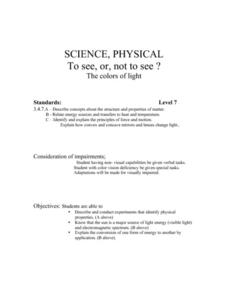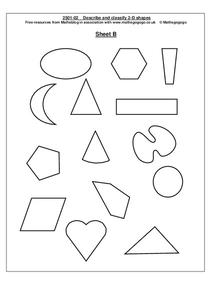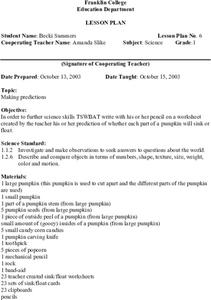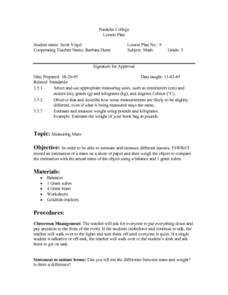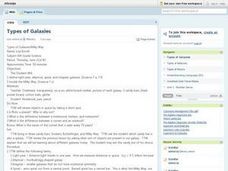Curated OER
Desinging and Using a Dichotomous Key
Young scholars are examine the purpose of dichotomous keys. In groups, they design their own in order to describe the characteristics of plants and weeds native to California. To end the lesson, they define new terminology associated...
Curated OER
Gravity Lesson
Fifth graders study the effects of mass on gravity. In this gravity lesson, 5th graders make model parachutes and helicopters in order to apply the scientific process and find out the effects of mass on drops of the 2 objects.
Curated OER
Water and Ice
Students observe water as it changes form. For this water lesson students observe, measure, and describe water as it changes state.
Curated OER
Swinging
Pupils examine and modify a swinging apparatus. They describe the motion of an object by its position, direction of motion, and speed. Students measure motion using a graph.
Curated OER
Using Inspiration To Support Logical Reasoning
Students share descriptions of science experiments they have conducted. They create a thin film on the surface of water in order to float light objects and observe that a paper clip does, indeed, float on the surface of the water at...
Curated OER
Setting Up Equations
In this setting up equations activity, students solve 4 different problems that include setting up the equations in each problem. They write out an equation or set up an equations that describe each given situation. Then, students state...
Curated OER
Tell Me More: Using Predicate Adjectives
In this predicate adjectives worksheet, students underline the predicate adjectives in 6 sentences. Students look for words that describe the subject.
Curated OER
Easy as Pi
Students describe the importance of structural features that increase surface area in a coral reef habitat. In this investigative lesson students quantify the impact of modifications on surface area in model habitats.
Curated OER
Math is Everywhere: Part 2
Second graders identify shapes and measurements in everyday life. In this measurement lesson, 2nd graders locate rectangles in their classroom and use standard and nonstandard forms to measure them. Students view a video clip...
Curated OER
Pattern
Students describe examples of the relationship between structure and function in living systems, particularly with regard to specialized tissues and organs. They describe examples of biological diversity and adaptation of organisms with...
Curated OER
To See or Not to See: The Colors of Light
Seventh graders describe and conduct an experiment that identifies the physical properties of light. They explore sources of visible light and an electromagnetic spectrum. Students explain the conversion of one form of energy to another.
Curated OER
Environment" The Mining Cycle
Students explore the world of mining and explain its importance in daily life. After describing how companies search for mineral deposits, they examine the environmental consequences of mining as well as the positive aspects. The...
Curated OER
Shapes
In this shapes worksheet, students identify shapes according to sentences that describe them. Students identify 8 shapes, but have 14 to choose from.
Curated OER
Changing Faces: A Study of Solar and Planetary Rotation Rates
Students determine rotation rates of a variety of solar system objects using images and the Internet.
Curated OER
Magic Bubble Prints
Students use magic bubbles to create designs on paper, and they are encouraged to relate their designs to objects they have seen in the world. They create a bubble print painting using a bubble and liquid watercolor mixture.
Curated OER
Teaching Matter with The Wild Christmas Reindeer
Second graders learn the proper way to take measurements, explore the properties of objects and expand their vocabulary.
Curated OER
"The Adventure of the Blue Carbuncle"
Seventh graders read Sherlock Holmes silently and work together to demonstrate an understanding of the story. They participate in small group and whole class discussions and analyze Holmes' method of deducing details about an object and...
Curated OER
Hanging Around
Students explore weight by building a spring scale and observing how it responds to objects with different masses. Each team of students can make their own spring scale by following steps which are specifically outlined in the plan. As...
Curated OER
Making Predictions
First graders write with his or her pencil on a worksheet created by the teacher his or her prediction of whether each part of a pumpkin will sink or float. They drop each of five objects in the water one at a time allowing enough time...
Curated OER
Measuring Mass
Third graders engage in a lesson that is concerned with the estimate and approximation of different masses. They weigh different objects and compare the different measurements and then use a balance to compare them. Students define the...
Curated OER
New Kids on the Block
Second graders identify and describe in their own language, the following 2-dimensional and 3-dimensional shapes: triangle, square, oblong (non-square rectangle), circle, oval, pentagon, hexagon, diamond, box, cylinder, and sphere. They...
Curated OER
Planets or Not, Here We Come!
Pupils, working in groups, research planets in terms of the size, temperature, number of moons, and potential for life. They use packets and worksheets as guides for their research. Students may role-play as aliens visiting their...
Curated OER
Types of Galaxies
Eighth graders take a quiz to review the different objects in space. As a class, they define terms related to galaxies. In groups, they make a model of the Milky Way galaxy using materials provided to them by their teacher. To end the...
Curated OER
Discovering Wind
Pupils discuss what they think wind is before listening to Pat Hutchins, The Wind Blew. Next, the go on a wind walk outside to look for signs of wind using their senses. As they walk, they teacher scribes their observations. The next...










